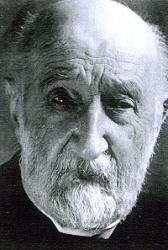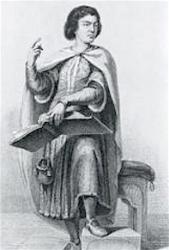Planning worship?
Check out our sister site, ZeteoSearch.org,
for 20+ additional resources related to your search.
- |
User Links
Person Results
W. J. Sparrow-Simpson

1859 - 1952 Person Name: W. J. Sparrow-Simpson, 1859-1952 Scripture: Isaiah 63:1 Author of "All for Jesus – all for Jesus" in Singing the Faith Simpson, William John Sparrow, M.A., was educated at Trin. College, Camb., B.A. 1882, M.A. 1886. Ordained in 1882, he held various appointments until 1904, when he became Chaplain to St. Mary's Hospital, Great Ilford. He has published several works, including a Memoir of Dr. W. S. Simpson, 1899. He contributed "All for Jesus—all for Jesus" (All for Jesus), and "Jesus, the Crucified, prays for me" (Passiontide), to C. W. A. Brooke's Additional Hymns, 1901). These hymns originally appeared in Sir J. Stainer's cantata The Crucifixion, 1887, the book of words of which was compiled by Mr. Simpson.
--John Julian, Dictionary of Hymnology, New Supplement (1907)
W. J. Sparrow-Simpson
John Stainer

1840 - 1901 Person Name: John Stainer, 1840-1901 Scripture: Isaiah 63:1 Composer of "ALL FOR JESUS" in Singing the Faith
John Stainer
Christoph Tietze
1641 - 1703 Person Name: C. Titius, 1641-1703 Scripture: Isaiah 63:16 Author of "Liebster Vater, ich, dein kind" in Deutsches Gesangbuch für die Evangelisch-Luterische Kirche in den Vereinigten Staaten Titius, Christoph, son of Christoph Titius or Tietze, pastor at Wilkau, near Kamslau, in Silesia, was born at Wilkau, May 24, 1641. He entered the St. Mary Magdalene Gymnasium, at Breslau, in 1654, and the Aegidien (St. Giles) Gymnasium at Nürnberg, in 1660. He matriculated as a student of Theology at the University of Altdorf, in 1662. After completing his studies at the University of Jena, in 1664, he acted for two years as a family tutor. On Aug. 24, 1666, he was ordained as pastor of Laubenzedel, near Gunzenhausen, in Franconia; and then became, in 1671, pastor at Henfenfeld, near Nürnberg. In 1685 he was appointed diaconus at Hersbruck, near Nürnberg, became archidiaconus in June, 1701, and in Nov., 1701, was appointed chief pastor and inspector of schools. He died at Hersbruck, Feb. 21, 1703 .
Titius had begun to write hymns while at the Nürnberg Gymnasium, and his best known hymns originated either then or during his University course. They appeared in his Sünden-Schmertzen, Trost im Hertzen, Todten-Kertzen, erwecket, entdecket, angestecket von Christophoro Titio Silesio, Theol. St., at Nürnberg, 1663 [Library of the Prediger-Serninar at Hannover], with 15 hymns; in the 2nd enlarged edition, published as Himmel-Heise, Seelen-Speise, Engel-Weise, &c. , Nürnberg, 1670 [Berlin Library], with 45 hymns; and in the 3rd further enlarged ed. published as Vorige und neue Morgen- und Abend-Catechismus . . . Lieder, &c., Nürnberg, 1701 [Gottingen Library] with 55 hymns. The most popular were those of the first edition many of which passed into the German hymn-books of the 17th century, and various of which are still found in recent collections. The best of them are hearty and popular in style, earnest and scriptural in tone, and sententious.
Two of Titius's hymns have passed into English, viz.:—
i. 0 du Schopfer aller Dinge. Holy Communion. This is a hymn of penitence before Holy Communion, and was first published in 1663, as above, as No. ii., in 9 stanzas of 8 lines. Translated as "Bow Thine ear, I now implore Thee." By Dr. H. Mills, 1845, p. 38.
ii. Sollt es gleich bisweilen scheinen. Cross and Consolation. His most popular hymn, first published in 1663, as No. vi., in 10 stanzas of 4 lines, entitled ”Hymn of Consolation." Included in Crüger's Praxis, 1675, the Nürnberg Gesang-Buch, 1676, Freylinghausen's Gesang-Buch, 1704, the Berlin Geistliche Lieder, 1863, No. 856, and many others, sometimes printed as 5 stanzas of 8 lines.
Lauxmann relates (Koch, viii. 488) that C. A. Dann, chief pastor of St. Leonard's Church, at Stuttgart, having spoken somewhat freely at the funeral of one of the courtplayers, had been relegated in 1812 to the village of Oieschingen in the Swabian Alb [in 1819 to the neighbouring village of Mössingen]. The king at last granted the earnest desire of the Stuttgart people for his return, and on Feb. 5, 1824, recalled him to Stuttgart. That night four friends walked over to Mössingen, and in the early morning conveyed the news to Dann by singing this hymn at the door of his room.
The translation in common use is:—
Seems it in my anguish lone. This is a good translation, omitting st. vi., by Miss Winkworth, in her Lyra Ger, 2nd Ser., 1858, p. 201; repeated in her Chorale Book for England, 1863, No. 146. Included in full in the Ohio Lutheran Hymnal, 1880, and abridged in the St. Aidan's College Hymn Book, 1864.
Other translations are:—
(1) "Yea should it ev'n to man appear." This is a translation of st. i., as st. v. of No. 1062, in the Supplement of 1808 to the Moravian Hymn Book, 1801 (1886, No. 505). (2) “Deem we sometimes, spirit-shaken." In L. Rehfuess's Church at Sea, 1868, p. 44, only st. i., vi. being from this hymn. [Rev. James Mearns, M.A.]
-- Excerpts from John Julian, Dictionary of Hymnology (1907)
Christoph Tietze
H. E. Engle
Scripture: Isaiah 63:17 Composer of "[There's a beautiful land far beyond the sky]" in Calvary Songs
H. E. Engle
Peter Abelard

1079 - 1142 Person Name: Peter Abelard (1079-1142) Scripture: Isaiah 63:1-4 Author of "Alone Thou Goest Forth, O Lord" in Common Praise (1998) Abelard, Peter, born at Pailais, in Brittany, 1079. Designed for the military profession, he followed those of philosophy and theology. His life was one of strange chances and changes, brought about mainly through his love for Heloise, the niece of one Fulbert, a Canon of the Cathedral of Paris, and by his rationalistic views. Although a priest, he married Heloise privately. He was condemned for heresy by the Council of Soissons, 1121, and again by that of Sens, 1140; died at St. Marcel, near Chalons-sur-Saône, April 21, 1142. For a long time, although his poetry had been referred to both by himself and by Heloise, little of any moment was known except the Advent hymn, Mittit ad Virginem, (q.v.). In 1838 Greith published in his Spicihgium Vaticanum, pp. 123-131, six poems which had been discovered in the Vatican. Later on, ninety-seven hymns were found in the Royal Library at Brussels, and pub. in the complete edition of Abelard's works, by Cousin, Petri Abelardi Opp., Paris, 1849. In that work is one of his best-known hymns, Tuba Domini, Paule, maxima (q.v.). Trench in his Sacra Latina Poetry, 1864, gives his Ornarunt terram germina (one of a series of poems on the successive days' work of the Creation), from Du Meril's Poesies Popul. Lat. du Moyen Age, 1847, p. 444.
-John Julian, Dictionary of Hymnology (1907)
Peter Abelard
William Tans'ur

1699 - 1783 Person Name: William Tans'ur (1706-1783) Scripture: Isaiah 63:1-4 Composer of "BANGOR" in Common Praise (1998) William Tansur, b. about 1700, Dunchurch of Barnes; d. 1783, St. Neots Evangelical Lutheran Hymnal, 1908
Also known as Tansur; Tanzer; le Tansur
William Tans'ur
Charitie Lees Smith
1841 - 1923 Person Name: Mrs. Charitie Lees Bancroft (1841- ) Scripture: Isaiah 63:1-2 Author of "He comes in blood-stained garments" in Carmina Sanctorum, a selection of hymns and songs of praise with tunes Bancroft, Charitie Lees, née Smith, daughter of the Rev. Sidney Smith, D.D., Rector of Drumragh, County Tyrone, Ireland; was born at Bloomfield, Merrion, in the county of Dublin, June 21,1841; and married, in 1869, to Arthur E. Bancroft. Her hymns have appeared in periodicals, Lyra Britannica, Bishop Ryle's Spiritual Songs, and other collections, and also as leaflets. The following have come into common usage:—
1. O for the [a] robes [robe] of whiteness. Heaven desired. This favorite children's hymn was 1st pub. as a leaflet in 1860. In 1867 it was included in Lyra Britannica, and thence has passed into several collections in Great Britain and America.
2. The King of glory standeth. Christ the Saviour. Contributed in 7 stanzas of 8 1ines to the Lyra Britannica, 1867, and entitled "Mighty to save." In the Hymns & Songs of Praise, N. Y., 1874, No. 1196, it begins with stanza iii., "He comes in bloodstained garments."
3. Before the throne of God above. The Advocate. Dated 1863, and given in Spurgeon's Our Own Hymn Book, 1806, Laudes Domini, N. Y., 1884.
In 1867 Mrs. Bancroft's hymns were collected and published as Within the Veil, by C. L. S.
-- John Julian, Dictionary of Hymnology (1907)
==========================
De Chenez, Charitie L. [Bancroft] née Smith, widow of Arthur Bancroft, p. 109, ii., is by a second marriage Mrs. De Chenez.
--John Julian, Dictionary of Hymnology, New Supplement (1907)
========================
She was apparently widowed twice. She died in Oakland, California, in 1923, at the age of 82, bearing the name Charitie de Cheney (or Chenez) - Dianne Shapiro
Charitie Lees Smith
Modesto Gonzalez
Person Name: Modesto González Scripture: Isaiah 63:9 Vers. esp. of "Cristo me ayuda por él a vivir" in Himnario Adventista del Séptimo Día
Modesto Gonzalez
D. W. Whittle

1840 - 1901 Person Name: Daniel W. Whittle (1840-1901) Scripture: Isaiah 63:9 Author of "Cristo me ayuda por él a vivir" in Himnario Adventista del Séptimo Día [Also published under the pseudonym El Nathan.]
===============
Whittle, D. W.. Six of his hymns (Nos. 295, 308,363, 385, 386, 417) are given in I. D. Sankey's Sacred Songs and Solos, under the signature of "El Nathan."
--John Julian, Dictionary of Hymnology, Appendix, Part II (1907)
D. W. Whittle
May Whittle Moody
1870 - 1963 Person Name: Mary Whittle Moody (1870-1963) Scripture: Isaiah 63:9 Composer of "[Cristo me ayuda por él a vivir]" in Himnario Adventista del Séptimo Día Mary (May) Jennette Whittle Moody 1870-1963. Born at Chicago, IL, daughter of hymnwriter, Daniel Webster Whittle (El Nathan), and, upon marrying, daughter-in-law to Dwight Lyman Moody, she attended Northfield School in MA (one of two schools founded there by D L Moody), after which she attended Oberlin College, Oberlin, OH. She then attended the Royal Academy of Music in London, England (1890-91). She became a singer, organist, composer, and hymn editor. She assisted her father and Dwight L Moody in their evangelistic work. In 1894 she married William Revell Moody, and they had four children: Irene, Dwight, Beatrice, and Virginia. Only Beatrice lived to adulthood, the others died before age six. She and her husband returned to Northfield, MA, where her husband headed the schools founded by his father. She had an organ in her home, and she collaborated with her father by composing some of the tunes for his hymn lyrics. The last year of his life, her father, Daniel, lived with them (he died in 1901). She died at East Northfield, MA.
John Perry
May Whittle Moody


 My Starred Hymns
My Starred Hymns


